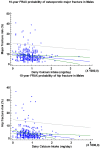First quantification of calcium intake from calcium-dense dairy products in Dutch fracture patients (the Delft cohort study)
- PMID: 24959951
- PMCID: PMC4073159
- DOI: 10.3390/nu6062404
First quantification of calcium intake from calcium-dense dairy products in Dutch fracture patients (the Delft cohort study)
Abstract
Recommendations for daily calcium intake from dairy products are variable and based on local consensus. To investigate whether patients with a recent fracture complied with these recommendations, we quantified the daily dairy calcium intake including milk, milk drinks, pudding, yoghurt, and cheese in a Dutch cohort of fracture patients and compared outcomes with recent data of a healthy U.S. cohort (80% Caucasians). An observational study analyzed dairy calcium intakes of 1526 female and 372 male Dutch fracture patients older than 50. On average, participants reported three dairy servings per day, independently of age, gender or population density. Median calcium intake from dairy was 790 mg/day in females and males. Based on dairy products alone, 11.3% of women and 14.2% of men complied with Dutch recommendations for calcium intake (adults ≤ 70 years: 1100 mg/day and >70 years: 1200 mg/day). After including 450 mg calcium from basic nutrition, compliance raised to 60.5% and 59.1%, respectively, compared to 53.2% in the U.S. cohort. Daily dairy calcium intake is not associated with femoral neck bone mineral density (BMD) T-scores or WHO Fracture Assessment Tool (FRAX) risk scores for major fracture or hip fracture. However, when sub analyzing the male cohort, these associations were weakly negative. The prevalence of maternal hip fracture was a factor for current fracture risks, both in women and men. While daily dairy calcium intake of Dutch fracture patients was well below the recommended dietary intake, it was comparable to intakes in a healthy U.S. cohort. This questions recommendations for adding more additional dairy products to preserve adult skeletal health, particularly when sufficient additional calcium is derived from adequate non-dairy nutrition.
Figures
Similar articles
-
Calcium intake and osteoporosis: the influence of calcium intake from dairy products on hip bone mineral density and fracture incidence - a population-based study in women over 55 years of age.Public Health Nutr. 2014 Feb;17(2):383-9. doi: 10.1017/S1368980012005307. Epub 2012 Dec 10. Public Health Nutr. 2014. PMID: 23217270 Free PMC article.
-
Calcium intakes and femoral and lumbar bone density of elderly U.S. men and women: National Health and Nutrition Examination Survey 2005-2006 analysis.J Clin Endocrinol Metab. 2012 Dec;97(12):4531-9. doi: 10.1210/jc.2012-1407. Epub 2012 Oct 15. J Clin Endocrinol Metab. 2012. PMID: 23071160
-
Dairy Intake Is Protective against Bone Loss in Older Vitamin D Supplement Users: The Framingham Study.J Nutr. 2017 Apr;147(4):645-652. doi: 10.3945/jn.116.240390. Epub 2017 Mar 1. J Nutr. 2017. PMID: 28250192 Free PMC article.
-
Effects of Milk and Dairy Products on the Prevention of Osteoporosis and Osteoporotic Fractures in Europeans and Non-Hispanic Whites from North America: A Systematic Review and Updated Meta-Analysis.Adv Nutr. 2019 May 1;10(suppl_2):S120-S143. doi: 10.1093/advances/nmy097. Adv Nutr. 2019. PMID: 31089740 Free PMC article.
-
Calcium and vitamin D nutrition and bone disease of the elderly.Public Health Nutr. 2001 Apr;4(2B):547-59. doi: 10.1079/phn2001140. Public Health Nutr. 2001. PMID: 11683549 Review.
Cited by
-
Cost-effectiveness of personalized supplementation with vitamin D-rich dairy products in the prevention of osteoporotic fractures.Osteoporos Int. 2016 Jan;27(1):301-8. doi: 10.1007/s00198-015-3319-3. Epub 2015 Sep 22. Osteoporos Int. 2016. PMID: 26395885 Free PMC article.
-
Public health impact and cost-effectiveness of dairy products supplemented with vitamin D in prevention of osteoporotic fractures.Arch Public Health. 2015 Dec 14;73:48. doi: 10.1186/s13690-015-0099-3. eCollection 2015. Arch Public Health. 2015. PMID: 26668740 Free PMC article. Review.
-
Urinary Calcium Excretion and Risk of Chronic Kidney Disease in the General Population.Kidney Int Rep. 2016 Dec 31;2(3):366-379. doi: 10.1016/j.ekir.2016.12.007. eCollection 2017 May. Kidney Int Rep. 2016. PMID: 29318214 Free PMC article.
-
Life-course approach to nutrition.Osteoporos Int. 2015 Dec;26(12):2723-42. doi: 10.1007/s00198-015-3288-6. Epub 2015 Sep 28. Osteoporos Int. 2015. PMID: 26412214 Free PMC article. Review.
-
Dietary acid load, trabecular bone integrity, and mineral density in an ageing population: the Rotterdam study.Osteoporos Int. 2017 Aug;28(8):2357-2365. doi: 10.1007/s00198-017-4037-9. Epub 2017 Apr 12. Osteoporos Int. 2017. PMID: 28405729 Free PMC article.
References
-
- Fulgoni V.L., III, Huth P.J., DiRienzo D.B., Miller G.D. Determination of the optimal number of dairy servings to ensure a low prevalence of inadequate calcium intake in Americans. J. Am. Coll. Nutr. 2004;2:651–659. - PubMed
-
- Beasley J.M., LaCroix A.Z., Neuhouser M.L., Huang Y., Tinker L., Woods N., Michael Y., Curb J.D., Prentice R.L. Protein intake and incident frailty in the women’s health initiative observational study. J. Am. Geriatr. Soc. 2010;58:1063–1071. doi: 10.1111/j.1532-5415.2010.02866.x. - DOI - PMC - PubMed
-
- National Institute for Public Health and the Environment RIVM . Den Haag; Voedingscentrum: 2006. [(accessed on 10 March 2012)]. NEVO-Tabel: Nederlands Voedingsstoffenbestand 2006/Stichting Nederlands Voedingsstoffenbestand. Available online: http://www.rivm.nl/Onderwerpen/Onderwerpen/N/Nederlands_Voedingsstoffenb....
-
- Dutch Dairy Board Kerncijfers Belangrijkste Zuivellanden 2010. [(accessed on 10 March 2012)]. Available online: http://www.prodzuivel.nl/pz/productschap/publicaties/Kerncijfers/Kerncij....
MeSH terms
Substances
LinkOut - more resources
Full Text Sources
Other Literature Sources
Medical



